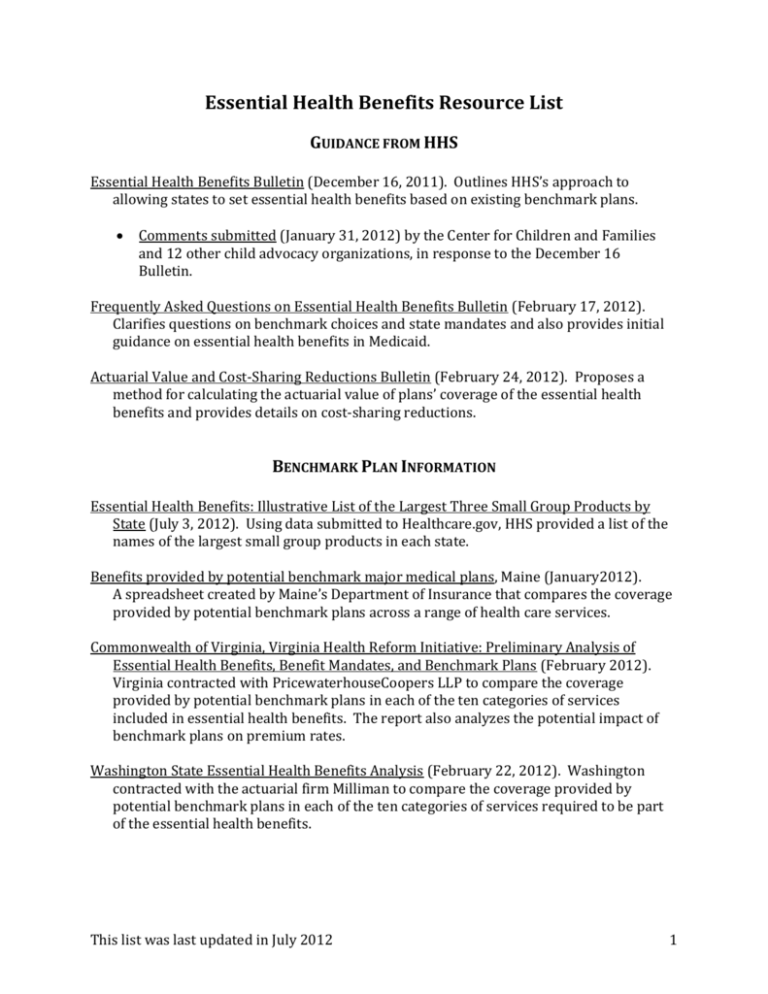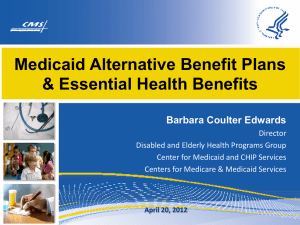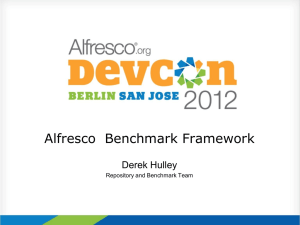Essential Health Benefits Resource List
advertisement

Essential Health Benefits Resource List GUIDANCE FROM HHS Essential Health Benefits Bulletin (December 16, 2011). Outlines HHS’s approach to allowing states to set essential health benefits based on existing benchmark plans. Comments submitted (January 31, 2012) by the Center for Children and Families and 12 other child advocacy organizations, in response to the December 16 Bulletin. Frequently Asked Questions on Essential Health Benefits Bulletin (February 17, 2012). Clarifies questions on benchmark choices and state mandates and also provides initial guidance on essential health benefits in Medicaid. Actuarial Value and Cost-Sharing Reductions Bulletin (February 24, 2012). Proposes a method for calculating the actuarial value of plans’ coverage of the essential health benefits and provides details on cost-sharing reductions. BENCHMARK PLAN INFORMATION Essential Health Benefits: Illustrative List of the Largest Three Small Group Products by State (July 3, 2012). Using data submitted to Healthcare.gov, HHS provided a list of the names of the largest small group products in each state. Benefits provided by potential benchmark major medical plans, Maine (January2012). A spreadsheet created by Maine’s Department of Insurance that compares the coverage provided by potential benchmark plans across a range of health care services. Commonwealth of Virginia, Virginia Health Reform Initiative: Preliminary Analysis of Essential Health Benefits, Benefit Mandates, and Benchmark Plans (February 2012). Virginia contracted with PricewaterhouseCoopers LLP to compare the coverage provided by potential benchmark plans in each of the ten categories of services included in essential health benefits. The report also analyzes the potential impact of benchmark plans on premium rates. Washington State Essential Health Benefits Analysis (February 22, 2012). Washington contracted with the actuarial firm Milliman to compare the coverage provided by potential benchmark plans in each of the ten categories of services required to be part of the essential health benefits. This list was last updated in July 2012 1 California Health Benefit Exchange: Comparison of Potential Health Benefit Benchmarks (February 13, 2012). California contracted with the actuarial firm Milliman to compare the coverage provided by potential benchmark plans in each of the ten categories of services included in essential health benefits. Rather than summarizing services that are covered by almost all comprehensive health plans, the analysis focuses on services where there is considerable variation between plans. Massachusetts Comparison of EHB Benchmark Plans (March 13, 2012). The state’s Division of Insurance compiled this table (Page 5) to allow for comparisons of benchmark plan options across 10 possible plans. The document also includes a list of questions for soliciting stakeholder feedback. State Health Official letter on children’s benchmark dental benefit packages (October 2009). Under the EHB Bulletin, when a benchmark plan lacks coverage for children’s dental benefits, states may use the dental benefit from the Federal Employees Dental and Vision Insurance Program or the state’s CHIP dental benefit. HHS has not yet published final regulations governing the CHIP dental benefit, but did publish a letter to state health officials outlining required dental benefits. Understanding the Difference Between Medicaid and EHB Benchmarks: How the Systems Work and Interact (June 2012). This NHeLP brief explains the difference between the two systems of benchmark benefits by providing an overview of each that includes: what populations the benchmarks will be provided to, states’ options for selecting each set of benchmark benefits, and the specific services that must be covered. Analysis of Cost Variations Summary of Cost Variations Among Benchmark Choices (February 21, 2012). For California, Milliman further examined the variation in the cost of benefit packages of the 10 benchmark choices, expressing the cost of each package as a percentage of a hypothetical minimum package. Vermont Essential Health Benefits: Estimated Pricing Impact of Benchmark Options (February 2012). The Wakely Consulting Group prepared this analysis for the state of Vermont. A detailed list of benefit differences by estimated impact is categorized by either moderately or slightly significant impacts. STATE ACTIVITY State Progress on Essential Health Benefits: This State Reforum chart is updated regularly as states make progress in reaching the milestones necessary to enact a benchmark plan. This list was last updated in July 2012 2 State EHB Materials: This State Reforum collection includes individually submitted comments from a handful of state governments, state advocates, and health care providers. INFORMATION ON STATE MANDATES State Benefit Mandates and National Health Reform (February 2012). The National Institute for Health Care Reform prepared this report that discusses the interaction of state benefit mandates and the EHBs. It uses the state of Maryland as an example of the costs that a state may incur to finance state mandates not covered by EHBs. For Maryland, choosing the small group market benchmark would result in the highest costs to defray for state mandates. Summary of Existing State Laws Mandating Health Benefits (December 2011). The National Conference of State Legislatures prepared this summary table of existing state laws mandating health benefits, as well as state mandated benefit evaluation laws. Health Insurance Benefit Mandates in California State Law (March 1, 2012). The California Health Benefits Review Program prepared two lists, the first lists existing state health insurance benefit mandates and the second list pertains to federal health insurance mandate laws. Both tables illustrate which markets are subject to each of the mandates. LAWS AND REGULATIONS Essential Health Benefits Requirements, Section 1302 of PPACA (42 U.S.C § 18022). Statutory requirements for the essential health benefits. State Flexibility in Benefit Packages, Section 1937 of the Social Security Act (42 U.S.C. 1396u-7). Sec. 1937 governs state flexibility in regard to Medicaid benchmark benefits. The benefits for newly eligible Medicaid enrollees must include essential health benefits referenced to a benchmark selected by the state Medicaid agency and must also be consistent with Sec. 1937. Health Benefits Coverage Options (42 CFR 457.410-450). Regulations implementing Sec. 1937. Actuarial report for benchmark-equivalent coverage (42 CFR 457.431). Under the EHB Bulletin, insurer-substituted benefits must remain actuarially equivalent to the benchmark plan. Actuarial equivalence will be measured using the standards set forth in this existing CHIP regulation. This list was last updated in July 2012 3 BLOG POSTS CCF Blog Series on Essential Health Benefits – These posts discuss key issues related to the essential health benefits, such as reviewing potential benchmark choices and actuarial value. HHS Suggests States Will Have Choices on Essential Health Benefits (December 19, 2011). Essential Health Benefits: A Child’s Experience (January 9, 2012). NASHP and Children’s Dental Health Project Issue Report (January 11, 2012). Essential Health Benefits: What Does the CHIP Experience Show Us? (January 16, 2012). CCF Shares Comments on the Essential Health Benefits (January 24, 2012). HHS Shares Info on Small Group Plans (January 26, 2012). Is Your State Reviewing Potential EHB Benchmarks? (January 31, 2012). HHS Signals Approach on Actuarial Value, Cost Sharing (February 29, 2012). Blogs Posts from Other Organizations States React to Essential Health Benefits Bulletin, NASHP (February 9, 2012). State Refor(u)m examined the comments submitted to HHS by several states in response to the December 16th EHB Bulletin in order to highlight states’ themes, such as the benchmark plan definition and affordability. The following blog posts shed light on the major components and initial concerns raised by the December 16th Bulletin from HHS. The Essential Health Benefits Bulletin: Happy Holidays? Community Catalyst (December 21, 2011). Implementing Health Reform: Essential Health Benefits and Medical Loss Ratio, Health Affairs Blog (February 18, 2012). OTHER RESOURCES Issue Briefs Creating A Usable Measure of Actuarial Value, Consumers Union (January 2012). This health policy synopsis covers a panel of experts convened by Consumers Union to discuss several key issues, including: how actuarial value will be utilized under the ACA, This list was last updated in July 2012 4 the issues associated with the interpretation and measurement of its use, and how to craft a measure that is accessible by consumers. Actuarial Value Under the Affordable Care Act, American Academy of Actuaries (July 2011). The ACA does not provide details on how actuarial value is to be calculated. Therefore, this issue brief provides insight into two of the commonly used methods for calculating actuarial value and explains the assumptions in those calculations. In addition, a hypothetical calculation of actuarial value is provided. Principles for Essential Health Benefits, Community Catalyst (December 2011). This brief suggests a set of principles that will unite consumer groups in their advocacy for robust essential health benefits, including a transparent development process, affordability, and comprehensiveness. Explaining Health Reform: Benefits and Cost-Sharing for Adult Medicaid Beneficiaries (August 2011). This brief from CCF and the Kaiser Commission for Medicaid and the Uninsured provides the details of the benefit and cost-sharing rules that will govern the coverage available to newly-eligible adult Medicaid beneficiaries. Reports Essential Health Benefits: Balancing Coverage and Cost, Institute of Medicine of the National Academies (October 2011). This report is the result of HHS’ request to IOM that it recommend a process that would help HHS define the benefits to be included under essential health benefits. Selected Medical Benefits: Report from the Department of Labor to the Department of Health and Human Services (April 15, 2011). This survey was used to assist the Secretary of HHS in ensuring that the scope of EHB are equal to the scope of typical employer-sponsored benefit plans. Other Resources on the Web Healthcare.gov: Newsroom: Essential Health Benefits. Defines essential health benefits and explains the intended approach of comprehensiveness and flexibility and also the process by which they arrived at that approach. HealthInsurance101: ACA Provisions: Essential Benefits Package. This website, sponsored by Community Catalyst and Georgetown University Health Policy Institute, provides a concise overview of essential health benefits, with links to related content, such as actuarial value and plan types. This list was last updated in July 2012 5








